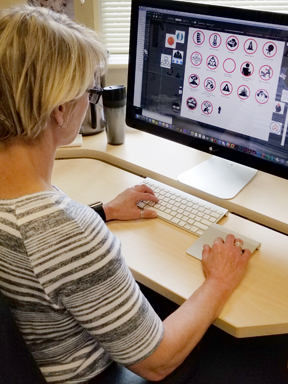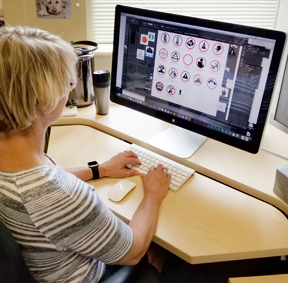Office Ergonomics - Computer Mouse - Location - Between Keyboard and Operator
On this page
- Is the space to the right of the keyboard the only one suitable for a computer mouse?
- What's a keyboard with a touchpad? And how can it be more comfortable for mouse users?
- How can placing a traditional computer mouse between the computer operator and the keyboard make things more comfortable and safe?
Is the space to the right of the keyboard the only one suitable for a computer mouse?
Back to topMost computer workstations have the mouse at the right hand of the keyboard (or the left hand, for left-handed people). While using the mouse here can be made more comfortable by using a mouse platform or a narrower keyboard (for details, see OHS Answers documents Computer Mouse - Selection and Use and Computer Mouse - Location - Beside Keyboard), there is another choice: you can also put the mouse between yourself and the keyboard. There are two ways of doing this: one is using a keyboard with a touchpad, and the other is by placing a separate mouse just in front of you, between you and the keyboard.
What's a keyboard with a touchpad? And how can it be more comfortable for mouse users?
Back to topThere are many keyboards which have a touchpad which is a small rectangular pad at the front of the keyboard which works like a mouse. The touchpad allows you to move your finger as though it were a cursor. Because it's positioned directly in front of you, you do not have to reach as far or as awkwardly as with a traditionally placed mouse. This placement reduced the risk of developing aches and pains associated with working in awkward positions.

Figure 1
How can placing a traditional computer mouse between the computer operator and the keyboard make things more comfortable and safe?
Back to topPlacing a computer mouse between you - the computer operator - and your keyboard can greatly improve your working posture because you do not have to reach as far to your side or as awkwardly as you would if the mouse were positioned to your right (or left). By putting the mouse directly in front of you, you are more balanced, supported, and comfortable, so you will feel less muscle fatigue and discomfort. It may also reduce the risk of injuries (e.g., work-related musculoskeletal disorders (WMSDs)).

Figure 2
So that the mouse can be easily operated in front of you, a cordless mouse is essential. It may be necessary to remove the arms of your chair so you can pull your chair towards your desk - as close as possible - to reduce reaching and overstretching your arms while typing. If using the keyboard for an extended period of time, you may wish to move the mouse to the side for that time and pull the keyboard forward.
- Fact sheet last revised: 2023-06-14

